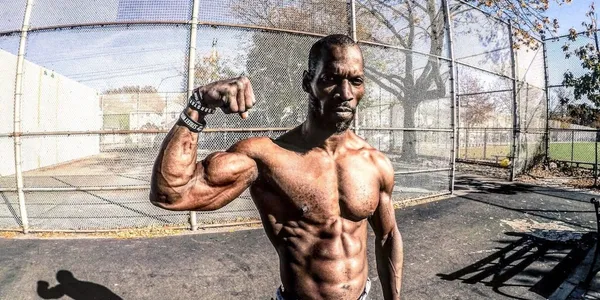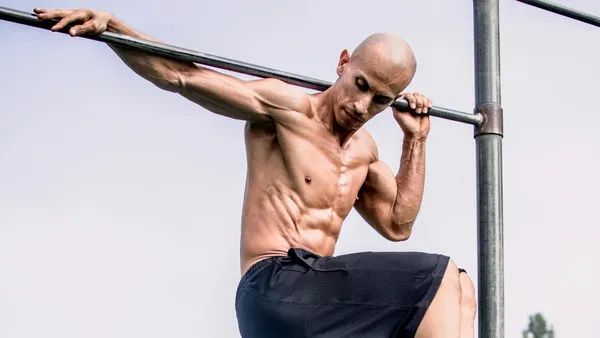Table of Contents
calisthenics athletes are a unique breed of fitness enthusiasts who use their own body weight to perform incredible feats of strength and agility. Whether they're flipping through the air, balancing on their hands, or hoisting themselves up on a single bar, calisthenics athletes push the limits of human movement. At Kizworld, we're passionate about calisthenics and the incredible athletes who make it look so effortless. In this article, we'll take a closer look at the world of calisthenics, from its history and benefits to the training methods and competitions that make it such a dynamic and exciting sport.
The Ultimate Guide to Becoming a Calisthenics Athlete: Master Your Body, Unleash Your Potential
What is a Calisthenics Athlete? | Benefits of Being a Calisthenics Athlete | How to Become a Calisthenics Athlete |
|---|---|---|
A calisthenics athlete is someone who uses their own body weight to perform exercises that develop strength, flexibility, and endurance. | Calisthenics is a great way to get in shape and improve your overall health. | To become a calisthenics athlete, you need to start by learning the basic exercises and gradually progress to more challenging ones. |
Calisthenics exercises can be done anywhere, making it a convenient and accessible form of exercise. | Calisthenics is a low-impact form of exercise, making it suitable for people of all ages and fitness levels. | Calisthenics is a great way to build strength, flexibility, and endurance. |
Calisthenics is a fun and challenging way to get in shape. | Calisthenics can help you improve your balance and coordination. | Calisthenics can help you reduce your risk of injury. |
I. A Day in the Life of a Calisthenics Athlete
Morning
A day in the life of a calisthenics athlete starts early. Most athletes wake up before the sun rises to get a workout in before the day gets too hot. A typical morning workout might include a warm-up, followed by a strength training session, and then a cool-down. After their workout, athletes will typically eat a healthy breakfast and then head to work or school.
Calisthenics athletes need to eat a healthy diet to fuel their workouts. A typical diet will include plenty of fruits, vegetables, whole grains, and lean protein. Athletes also need to drink plenty of water to stay hydrated.
Meal | Time | Foods |
|---|---|---|
Breakfast | 7:00 AM | Oatmeal with fruit and nuts, eggs, whole-wheat toast |
Lunch | 12:00 PM | Salad with grilled chicken, brown rice, and vegetables, sandwich on whole-wheat bread |
Dinner | 6:00 PM | Grilled salmon with roasted vegetables, quinoa, chicken stir-fry |
Afternoon
After work or school, calisthenics athletes will often have another workout. This workout might focus on flexibility, endurance, or skill work. Athletes may also use this time to practice for competitions or to work on new skills.
In addition to their workouts, calisthenics athletes also need to make time for rest and recovery. This is important to allow their bodies to repair themselves and to prevent injuries. Athletes may use this time to stretch, foam roll, or simply relax.
- How to Do a Muscle Up
- The Best Calisthenics Gifts and Accessories
- The Best Calisthenics Quotes and Motivation
Evening
In the evening, calisthenics athletes will typically wind down by spending time with family and friends, reading, or watching TV. They will also need to get a good night's sleep so that they are ready to do it all again the next day.
Being a calisthenics athlete is a demanding lifestyle, but it is also very rewarding. Athletes enjoy the challenge of pushing themselves to their limits and seeing the results of their hard work. They also enjoy the sense of community that comes from being part of a team or group of like-minded individuals.
If you are interested in becoming a calisthenics athlete, there are many resources available to help you get started. You can find books, articles, and videos online, or you can join a local calisthenics group or gym.
With hard work and dedication, you can achieve your calisthenics goals and become a stronger, healthier, and more confident person.
Here are some tips for becoming a calisthenics athlete:
- Start slowly and gradually increase the intensity and duration of your workouts.
- Listen to your body and rest when you need to.
- Eat a healthy diet and drink plenty of water.
- Find a workout buddy or group to help you stay motivated.
- Set realistic goals and don't be afraid to challenge yourself.
With hard work and dedication, you can achieve your calisthenics goals and become a stronger, healthier, and more confident person.
A Day in the Life of a Calisthenics Athlete
II. Nutrition and Supplementation for Calisthenics Athletes
Calisthenics athletes require proper nutrition and supplementation to fuel their demanding workouts and support their recovery and growth. A balanced diet rich in whole foods, including fruits, vegetables, lean proteins, and healthy fats, is essential for optimal performance. Here are some specific nutritional considerations for calisthenics athletes:
**Protein intake:** Protein is crucial for building and repairing muscle tissue. Calisthenics athletes should aim to consume 1.6-2.2 grams of protein per kilogram of body weight daily. Good sources of protein include lean meats, poultry, fish, beans, lentils, and tofu.
Supplementation can also play a beneficial role in supporting the nutritional needs of calisthenics athletes. Creatine is a popular supplement that can enhance power and strength, while beta-alanine can buffer lactic acid accumulation, delaying muscle fatigue. Protein powders and amino acid supplements can also be useful for meeting increased protein requirements.
Proper hydration is also vital for calisthenics athletes. Water helps regulate body temperature, lubricates joints, and transports nutrients and oxygen to muscles. Athletes should aim to drink plenty of water throughout the day, especially before, during, and after workouts.
Creatine | Beta-Alanine | Protein Powder |
Calisthenics athletes can also benefit from incorporating specific foods into their diet to support their training and recovery. For example, tart cherry juice has anti-inflammatory properties that can help reduce muscle soreness, while bananas are a good source of potassium, which is important for muscle function and hydration.
Overall, a balanced and nutritious diet, combined with appropriate supplementation and hydration, is essential for calisthenics athletes to optimize their performance, recovery, and long-term health.
Nutrition and Supplementation for Calisthenics Athletes
III. Building a Calisthenics Workout Plan
Start with the Basics
Calisthenics is a great way to get in shape and improve your overall health. But if you're new to calisthenics, it's important to start with the basics. This means learning the proper form for each exercise and gradually increasing the difficulty of your workouts as you get stronger.There are a number of different calisthenics exercises that you can do, but some of the most basic and effective include:* Push-ups* Pull-ups* Squats* Lunges* PlanksThese exercises can be combined to create a variety of different workout routines. For example, you could do a circuit of push-ups, pull-ups, squats, and lunges, or you could do a Tabata workout that consists of 8 rounds of 20 seconds on, 10 seconds off.No matter what type of workout you choose, it's important to listen to your body and rest when you need to. Calisthenics can be challenging, but it's important to avoid overtraining and injury.How to Get Started with Calisthenics as a Beginner
Set Realistic Goals
When you're starting out, it's important to set realistic goals for yourself. Don't expect to be able to do a muscle-up or a handstand on your first day. Just focus on learning the basics and gradually increasing the difficulty of your workouts as you get stronger.It's also important to be patient. Calisthenics is a skill that takes time to develop. Don't get discouraged if you don't see results immediately. Just keep practicing and you will eventually reach your goals.How to Train Like a Calisthenics Pro
Listen to Your Body
Calisthenics can be challenging, but it's important to listen to your body and rest when you need to. Don't push yourself too hard, especially when you're first starting out. If you experience any pain, stop exercising and consult with a doctor.It's also important to warm up before each workout and cool down afterwards. This will help to prevent injuries.How to Improve Your Posture
Building a Calisthenics Workout Plan
IV. Common Mistakes to Avoid as a Calisthenics Athlete
1. Not Warming Up Properly
Warming up is essential for any workout, but it's especially important for calisthenics athletes. Calisthenics exercises are often very demanding and can put a lot of stress on your joints and muscles. If you don't warm up properly, you're more likely to get injured.
Make sure to warm up for at least 5-10 minutes before each workout. Start with some light cardio, such as jumping jacks or running in place. Then, do some dynamic stretches, such as arm circles and leg swings. Once you're warmed up, you can start your workout.
Read more: The Best Calisthenics Books and Podcasts
2. Trying to Do Too Much Too Soon
When you're first starting out with calisthenics, it's important to start slowly and gradually increase the difficulty of your workouts. If you try to do too much too soon, you're more likely to get injured or burn out.
Start with the basics and focus on building a strong foundation. Once you've mastered the basics, you can start to add more challenging exercises to your workouts.
3. Not Listening to Your Body
It's important to listen to your body and rest when you need to. If you're feeling pain, stop exercising and rest. Pushing yourself too hard can lead to injuries.
Make sure to get enough sleep and eat a healthy diet. These things will help you recover from your workouts and reduce your risk of injury.
Related: How to Learn the Basic Calisthenics Skills and Progressions
4. Not Stretching
Stretching is an important part of any fitness routine, but it's especially important for calisthenics athletes. Calisthenics exercises can shorten your muscles, so it's important to stretch regularly to improve your flexibility and range of motion.
Make sure to stretch for at least 10 minutes after each workout. Focus on stretching the muscles that you worked during your workout.
5. Not Eating a Healthy Diet
Eating a healthy diet is essential for any athlete, but it's especially important for calisthenics athletes. Calisthenics exercises are very demanding and require a lot of energy. If you don't eat a healthy diet, you're more likely to get injured or burn out.
Make sure to eat plenty of fruits, vegetables, and whole grains. These foods will give you the energy you need to power through your workouts.
Related: The Most Common Calisthenics Mistakes (And How to Fix Them)
Mistake | Consequence | Solution |
|---|---|---|
Not warming up properly | Increased risk of injury | Warm up for at least 5-10 minutes before each workout |
Trying to do too much too soon | Increased risk of injury or burnout | Start slowly and gradually increase the difficulty of your workouts |
Not listening to your body | Injuries | Rest when you need to and don't push yourself too hard |
Not stretching | Reduced flexibility and range of motion | Stretch for at least 10 minutes after each workout |
Not eating a healthy diet | Increased risk of injury or burnout | Eat plenty of fruits, vegetables, and whole grains |
Common Mistakes to Avoid as a Calisthenics Athlete
V. Conclusion
Calisthenics athletes are amazing individuals who have dedicated their lives to mastering their bodies and minds. They are a source of inspiration for us all, and they remind us that anything is possible if we set our minds to it. If you are interested in becoming a calisthenics athlete, there are many resources available to help you get started. There are books, websites, and even online communities where you can connect with other calisthenics enthusiasts. With hard work and dedication, you can achieve your calisthenics goals and become the best version of yourself.